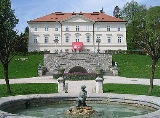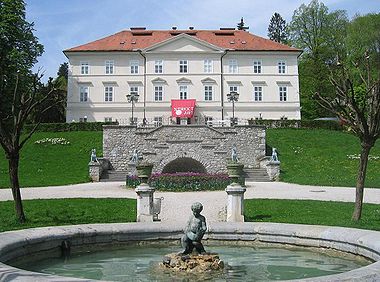
Tivoli Castle
Encyclopedia

Mansion
A mansion is a very large dwelling house. U.S. real estate brokers define a mansion as a dwelling of over . A traditional European mansion was defined as a house which contained a ballroom and tens of bedrooms...
in Ljubljana
Ljubljana
Ljubljana is the capital of Slovenia and its largest city. It is the centre of the City Municipality of Ljubljana. It is located in the centre of the country in the Ljubljana Basin, and is a mid-sized city of some 270,000 inhabitants...
, the capital of Slovenia
Slovenia
Slovenia , officially the Republic of Slovenia , is a country in Central and Southeastern Europe touching the Alps and bordering the Mediterranean. Slovenia borders Italy to the west, Croatia to the south and east, Hungary to the northeast, and Austria to the north, and also has a small portion of...
.
The mansion is located in the city's Tivoli Park
Tivoli, Ljubljana
Tivoli Park is the largest park in Ljubljana, the capital of Slovenia. It is located on the outskirts of the Center district, stretching to the Šiška district to the north, the Vič district to the south, and the Rožnik district to the west. The park was laid out during the French imperial...
(part of the Rožnik
Rožnik
The Rožnik District or simply Rožnik is a city district of Ljubljana, the capital of Slovenia. It consists of much of Rožnik Hill and includes also Tivoli Park. The Ljubljana Zoo is located here....
neighborhood), north-west of (and visible from) the city centre, at the foot of Rožnik
Rožnik
The Rožnik District or simply Rožnik is a city district of Ljubljana, the capital of Slovenia. It consists of much of Rožnik Hill and includes also Tivoli Park. The Ljubljana Zoo is located here....
hill. It is the terminus of the Jakopič Promenade (formerly the Lantieri Promenade), itself the continuation of Cankar Street.
Built in the 17th century atop the ruins of a previous Renaissance-period castle, the mansion was initially owned by the Jesuits, but came into the possession of the Diocese of Ljubljana
Roman Catholic Archdiocese of Ljubljana
The Roman Catholic Metropolitan Archdiocese of Ljubljana is an ecclesiastical territory or diocese of the Roman Catholic Church in Slovenia. It was erected as the Diocese of Ljubljana by Pope Eugene IV on 6 December 1461 and was immediately subject to the Holy See from its creation until erected...
following the 1773 suppression of the Jesuit order. Used as the bishop's summer residence, it was surrounded with orchards.
In the mid-19th century, it was bought by the Austrian emperor
Austrian Empire
The Austrian Empire was a modern era successor empire, which was centered on what is today's Austria and which officially lasted from 1804 to 1867. It was followed by the Empire of Austria-Hungary, whose proclamation was a diplomatic move that elevated Hungary's status within the Austrian Empire...
Francis Joseph I, who in 1852 presented it as a gift to the veteran Habsburg marshal
Marshal
Marshal , is a word used in several official titles of various branches of society. The word is an ancient loan word from Old French, cf...
Joseph Radetzky. Radetzky renovated the mansion in the Neoclassical style, giving it its present appearance, and spent much of his retirement in it with his wife Francisca von Strassoldo Grafenberg, a local Carniola
Carniola
Carniola was a historical region that comprised parts of what is now Slovenia. As part of Austria-Hungary, the region was a crown land officially known as the Duchy of Carniola until 1918. In 1849, the region was subdivided into Upper Carniola, Lower Carniola, and Inner Carniola...
n noblewoman.
Twelve years after Radetzky's death in 1858, a statue of the famous general was erected on the plaze at the top of the stairs leading to the castle, guarded by four cast-iron dogs made by the sculptor Anton Fernkorn. The monument was removed after the dissolution of Austria-Hungary
Austria-Hungary
Austria-Hungary , more formally known as the Kingdoms and Lands Represented in the Imperial Council and the Lands of the Holy Hungarian Crown of Saint Stephen, was a constitutional monarchic union between the crowns of the Austrian Empire and the Kingdom of Hungary in...
in 1918, and placed in the National Museum of Slovenia
National Museum of Slovenia
The National Museum of Slovenia is located in Ljubljana, the capital of Slovenia. It is situated in the Center district of the city near the Tivoli Park....
, but the dogs have remained in their original places.
In 1863, the mansion was bought by the Municipality of Ljubljana, who used it as (among other things) a poorhouse, later subdividing ot into condominiums. In 1967, it was again renovated and became the venue for the International Graphic Arts Centre .
An alpine-style building called the Švicarija ("Swissery", formerly the Hotel Tivoli) stands behind the mansion. The Jesenkova educational footpath behins alongside it.

